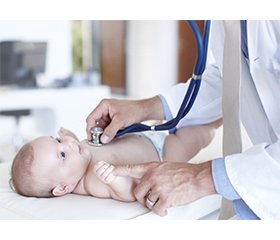Список литературы
1. Abaturov AE, Kryuchko TA. Modern and promising etiological therapy of bacterial pneumonia. 1. Antibacterial therapy of community-acquired pneumonia. Child’s Health. 2017;3(12):382-389. doi: 10.22141/2224-0551.12.3.2017.104231.
2. Jane S, Williams DJ, Arnold S, Ampofo K, Bramley AM, et al. Community-acquired pneumonia in children in the United States requi–ring hospitalization. English Language and Medicine. 2015;372:835-845. doi: 10.1056/NEJMoa1405870.
3. Zar HJ, Barnett W, Stadler A, Gardner-Lubbe S, Mayer L, Nikol MP. The etiology of childhood pneumonia in a well-vaccinated group of South African newborns: a case-control study as part of the Dra–kenstein Child Health Study. Lancet Respir Med Zeitschrift. 2016;4:463-472. doi: 10.1016/S2213-2600(16)00096-5.
4. The research group on the etiology of pneumonia in the interests of children’s health (PERCH). Causes of severe pneumonia requi–ring hospitalization in children from Africa and Asia who are not infected with HIV: the PERCH transnational case control study. Lancet Journal. 2019;394:757-779. doi: 10.1016/S0140-6736(19)30721-4.
5. Bradley JS, Byington KL, Shah SS, Alverson B, Carter ER, et al. Treatment of community-acquired pneumonia in infants and children older than 3 months: Guidelines for clinical practice, compiled by the US Department of Health. The Society for Pediatric Infectious Diseases and the American Society for Infectious Diseases. Clinical Infectious Diseases. 2011;53:e25-76. doi: 10.1093/cid/cir531.
6. Harris M, Clark J, Coote N, Fletcher P, Harnden A, et al., on behalf of the British Thoracic Society Standards of Care Committee. British Thoracic Society guidelines for the management of community acquired pneumonia in children: update 2011. Thorax. 2011;66(2):1-23. doi: 10.1136/thoraxjnl-2011-200598.
7. Karimdzhanov IA, Iskanova GKh, Isroilova NA. Sequential therapy of community-acquired pneumonia in children. Child’s Health. 2014;3(54):70-73. doi: 10.22141/2224-0551.3.54.2014.76003.
8. Haq IJ, Battersby AC, Eastham K, Mckean M. Community acquired pneumonia in children. BMJ. 2017;356:j686. doi: 10.1136/bmj.j686.
9. Danino D, Ben-Shimol S, Van Der Beek BA, Givon-Lavi N, Avni YS, et al. Decline in pneumococcal disease in young children du–ring the coronavirus disease 2019 (COVID-19) pandemic in Israel associated with suppression of seasonal respiratory viruses, despite persistent pneumococcal carriage: a prospective cohort study. Clin Infect Dis. 2022;75:e1154-e1164. doi: 10.1093/cid/ciab1014.
10. Meyer Sauteur PM, Beeton ML, on behalf of the ESGMAC and the ESGMAC Mycoplasma pneumoniae Surveillance (MAPS) study group. Mycoplasma pneumoniae: delayed re-emergence after COVID-19 pandemic restrictions. Lancet Microbe. 2023;23:S2666-5247(2623)00344-00340. doi: 10.1016/S2666-5247(23)00344-0.
11. Ambroggio L, Sucharew H, Rattan MS, O’Hara SM, Babcock DS, et al. Lung ultrasonography: a viable alternative to chest radio–graphy in children with suspected pneumonia? J Pediatr. 2016;176(93-98):e97. doi: 10.1016/j.jpeds.2016.05.033.
12. Feikin DR, Hammitt LL, Murdoch DR, O’Brien KL, Scott JAG. The enduring challenge of determining pneumonia etiology in children: considerations for future research priorities. Clin Infect Dis. 2017;64:188-96. doi: 10.1093/cid/cix143.
13. Sauteur PM, Trück J, van Rossum AMC, Berger C. Circulating antibody-secreting cell response during Mycoplasma pneumoniae childhood pneumonia. J Infect Dis. 2020;222:136-147. doi: 10.1093/infdis/jiaa062.
14. Meyer Sauteur PM. A limited role for microbiological testing for childhood lower respiratory tract infections in primary care: managing diagnostic uncertainty by withholding antibiotics and watchful waiting. Clin Microbiol Infect. 2022;28:1189-1192. doi: 10.1016/j.cmi.2022.06.012.
15. Li Q, Zhou Q, Florez ID, Mathew JL, Shang L, et al. Short-course vs long-course antibiotic therapy for children with nonsevere community-acquired pneumonia: a systematic review and meta-analysis. JAMA Pediatr. 2022;176:1199-1207. doi: 10.1001/jamapediatrics.2022.4123.
16. Pernica JM, Harman S, Kam AJ, Carciumaru R, Vanniyasingam T, et al. Short-course antimicrobial therapy for pediatric community-acquired pneumonia: the SAFER randomized clinical trial. JAMA Pediatr. 2021;175:475-482. doi: 10.1001/jamapediatrics.2020.6735.
17. Bielicki JA, Stohr W, Barratt S, Dunn D, Naufal N, et al. Effect of amoxicillin dose and treatment duration on the need for antibiotic re-treatment in children with community-acquired pneumonia: the –CAP-IT randomized clinical trial. JAMA. 2021;326:1713-1724. doi: 10.1001/jama.2021.17843.
18. Kuitunen I, Jaaskelainen J, Korppi M, Renko M. Antibiotic treatment duration for community-acquired pneumonia in outpatient children in high-income countries — a systematic review and meta-analysis. Clin Infect Dis. 2023;76:e1123-e1128. doi: 10.1093/cid/ciac374.
19. Alcoba G , Keitel K, Maspoli V, et al. A three-step diagnosis of pediatric pneumonia at the emergency department using clinical predictors, C-reactive rotein, and pneumococcal PCR. Eur J Pediatr. 2017;176:815-24. doi: 10.1007/s00431-017-2913-0.
20. Mayor-Ibarguren A, Feito-Rodriguez M, González-Ramos J, et al. Mucositis secondary to Chlamydia pneumoniae infection: expanding the Mycoplasma pneumoniae-induced rash and mucositis concept. Pediatr Dermatol. 2017;34(4):465-472. doi: 10.1111/pde.13140.
21. Biondi E, Mcculloh R, Alverson B, Klein A, Dixon A. Treatment of mycoplasma pneumonia: a systematic review. Pediatrics. 2014;133:1081-1090. doi: 10.1542/peds.2013-3729.
22. Dosage recommendations according to the Swiss Database for dosing medicinal products in paediatrics. Available from: https://db.swisspeddose.ch.
23. Huang W, Xu X, Zhao W, Cheng Q. Refractory Mycoplasma pneumoniae in Children: A Systematic Review and Meta-analysis of Laboratory Features and Predictors. J Immunol Res. 2022 Jun 26;2022:9227838. doi: 10.1155/2022/9227838.

